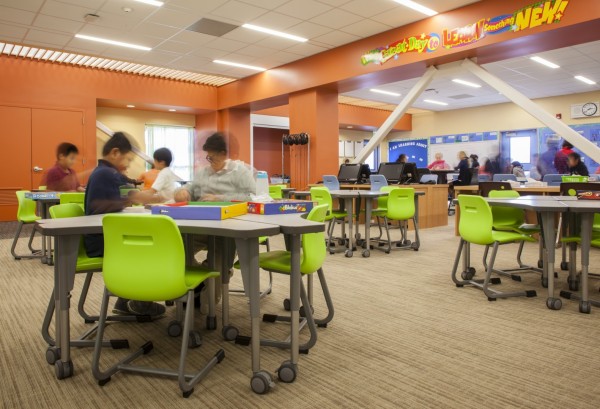By Alex Parslow, Sr. Vice President Pre-K-12 Education
What would you do if you could design your school from the ground up? This was the question from the Superintendent of Milpitas Unified School District who challenged principals and teachers to design a “facility to inspire creativity, positive energy, innovation, and joy.” The outcome of this dynamic mandate was the creation of three HMC designed Learning Centers for Milpitas Unified that were recently honored by the Coalition for Adequate School Housing (C.A.S.H.) and the AIACC with this year’s Leroy F. Greene Design + Planning Award.
The limited budgets for these projects required that structural alterations be kept to a minimum. Yet, our HMC design team was able—through strategic wall removal and the introduction of flexible partitions—to convert what had been small spaces typical of the factory model common in schools constructed in that era, into exciting 21st century learning environments. Previously concealed elements such as clerestory windows, glulam beams, and wood trusses were uncovered and reintroduced into the spaces. As a result, the Learning Centers offer large, flexible spaces filled with natural daylight. A variety of bright colors in carpets and paint were selected to create visual interest appealing to young students—and to match the level of energy and enthusiasm for learning that these spaces engender.
The spaces provide flexible and personalized learning environments where classes can be combined, and learning can be imagined in new ways, one of the tenets of 21st century education. For example, a single teacher with two instructional aides may conduct a lesson with 80 or more students in a hands-on lab activity in one room, while others can work on different activities in the adjacent room. This flexible configuration both frees up teachers for preparation and collaboration time and gives teachers greater control in deciding how the environment best facilitates student learning.
After a year of using the Learning Centers, Milpitas USD is already moving away from its original intent of using the spaces for students to work almost exclusively on instructional software on Chromebooks. Since the Learning Centers have proven to be so flexible, teachers are able to use the spaces for new, inventive purposes, such as S.T.E.M. laboratories and makerspaces.

